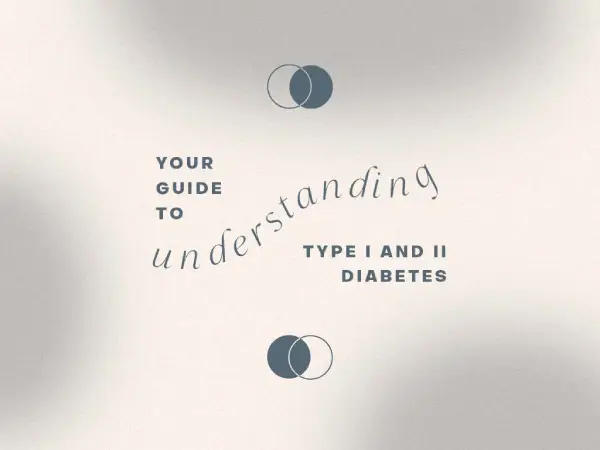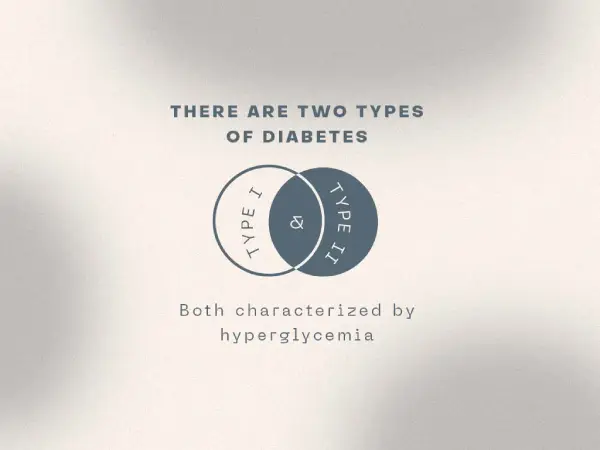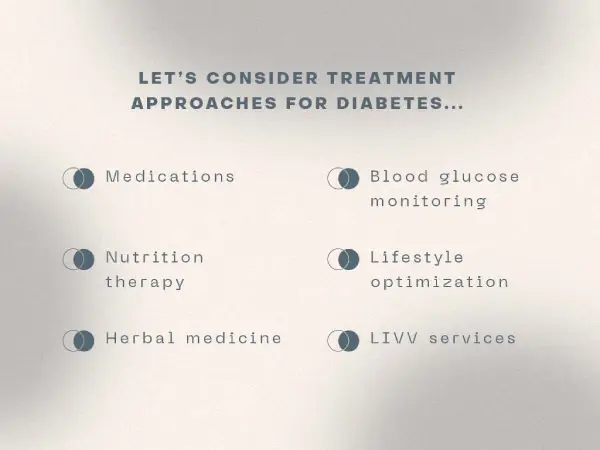Blog
Your Guide to Understanding Type I and II Diabetes

Diabetes is the most common of all endocrine disorders- in fact, about 1 in every 10 people in the United States has diabetes, and about 90-95% of all diagnosed cases worldwide are type II diabetes. Did you know that diabetes is the 7th leading cause of death in the U.S and that people with diabetes have 2x higher risk of death? As you can imagine, this is a top public health concern and unfortunately, prevalence around the globe continues to increase. Need I say more to persuade you of the importance of learning more about it?
Let’s first have a quick lesson in physiology…
There are certain anatomy and physiology concepts we must be familiar with to truly understand diabetes – but learning about the body is fascinating, so get excited!
The pancreas – the pancreas is a 6-inch long, pear-shaped organ located in the abdomen, right behind the stomach, that makes and releases insulin from specific cells called beta cells.
Insulin – insulin is a hormone released, primarily after eating, from the pancreas into the bloodstream that allows the glucose to enter cells of the body.
Blood glucose – glucose is a simple sugar that comes from the diet or body stores and there is always a constant supply in the blood because it is our body’s primary fuel source.
So, let’s put it all together – after meals, particularly those containing carbohydrates and sugars, blood glucose rises and the pancreas releases just the right amount of insulin to take that extra glucose into cells so that it can be turned into energy or stored for later.
Sounds simple right? Well, it can become complicated if diabetes becomes part of the picture.
Let’s talk type I and type II diabetes …
Diabetes mellitus is a diverse group of disorders, rather than a single disease. There are two types of diabetes, type I and type II, both characterized by hyperglycemia (AKA high blood sugar) from defects in insulin production, insulin action, or both. It is important to distinguish between the two types because each has different causative factors and treatment approaches.
Type I diabetes mellitus (T1DM) is the result of destruction of beta cells in the pancreas causing an insulin deficiency – this means there is no insulin available to let glucose into cells. Immune-mediated type I diabetes is an autoimmune response triggered by the interaction of environmental factors (possibly viruses, gluten, vitamin D status, length of breastfeeding, and exposure to cow’s milk proteins) in genetically susceptible individuals. There are forms of T1DM, called fulminant T1DM, that have no known cause. The onset of T1DM is sudden and usually occurs in childhood (although it is increasingly diagnosed in adults and the elderly). People with T1DM are dependent on insulin therapy for their entire lives but benefit greatly from nutrition and lifestyle interventions.
Type II diabetes mellitus (T2DM) is the result of metabolic dysfunction that leads to altered insulin release and insulin resistance – this means that insulin can be over- or under-produced and that cells are unable to use it to let glucose in. Primary risk factors that contribute to its development include obesity, metabolic syndrome, poor nutrition, physical inactivity, impaired glucose metabolism, history of gestational diabetes, and family history of T2DM. The onset of T2DM is gradual and usually occurs in adults (although diagnosis in children and adolescents is increasing). People with T2DM are classically managed with medication (such as Metformin), nutrition therapy, and lifestyle intervention – however, insulin therapy may be needed in certain cases.
Let’s review clinical biomarkers of blood sugar status…
Measuring and tracking these biomarkers is critical for the treatment and management of anyone with blood sugar imbalance, including those with metabolic syndrome, prediabetes, type I diabetes, or type II diabetes. Here are the primary biomarkers tested that reflect blood sugar status:
| Fasting Blood Glucose (FBG) | Glycated hemoglobin (HbA1c) | Fasting Insulin |
| This measures the amount of glucose in the blood while in a fasted state (no food consumed for 8-12 hours before). This is a snapshot in time, each measurement varies depending on recent diet and other factors. Normal levels are 70-99 mg/dL. | This measures the amount of sugar attached to red blood cells, which correlates with the average percentage of glucose in the blood over the past 2-3 months. This is a better marker of blood sugar than FBG alone. Normal levels are less than 5.6%. | This measures the amount of insulin in the blood in a fasted state (no food consumed for 8-12 hours before). In the development of T2DM, insulin is the first to rise but may decrease in later stages. Normal levels are 2-19 mIU/mL. |
People with blood sugar imbalance will likely show abnormal levels of the biomarkers listed above. People with type I and type II diabetes have different goal ranges for biomarkers than people without diabetes. Here is a brief explanation of these abnormal levels and goal ranges:
| Metabolic Syndrome & Prediabetes | Type I & Type II Diabetes |
| People with metabolic syndrome will have elevated FBG (110 mg/dL or higher) in addition to abdominal obesity, insulin resistance, altered lipid levels, and high blood pressure.
People with prediabetes will have an elevated HbA1c (5.7-6.4%) and they are likely to have other markers of metabolic syndrome. The goal for HbA1c in prediabetes is less than 6%. Ask your ND at LIVV for the goal ranges of BG before and after meals. |
These people will have one or more of the following: an elevated HbA1c (6.5% or higher), an elevated FBG (126 mg/dL or higher), symptoms of diabetes with a random BG of 200 mg/dL or higher, or a 2-hour post-prandial glucose (OGTT) of 200 mg/dL or higher. The goal for HbA1c in diabetes is less than 7%. Ask your ND at LIVV for the goal ranges of BG before and after meals. |
Keep in mind, ranges may vary and additional markers and comprehensive panels may also be tested. All necessary and advanced lab testing can be done with a naturopathic doctor (ND) at LIVV! Remember, NDs don’t settle for standard ranges that just keep you out of disease states, they strive for optimal levels that push you to be your healthiest self.
Signs, symptoms, and complications of diabetes…
The body tries to keep glucose in a tight range within the bloodstream. When glucose levels go out of this range, the body lets us know by responding with certain signs and symptoms. Here are the main scenarios of this:
- When blood sugar is too high (hyperglycemia)
- When blood sugar levels rise above normal, symptoms may include increased urination, increased thirst, increased hunger, blurred vision, weight loss, low energy, irritability, and delayed wound healing.
- When blood sugar levels rise severely above normal (BG of 250 mg/dL or higher), a life-threatening condition known as diabetic ketoacidosis (DKA) may develop – symptoms may include fruity-scented breath, rapid/shallow breathing, nausea/vomiting, abdominal pain, fatigue/weakness, and confusion. This is a medical emergency and requires immediate treatment.
- High blood sugar over time is damaging to vessels and tissues and may lead to organ dysfunction and failure – such as in the eyes (causing blindness), kidneys (causing chronic kidney disease), nerves (causing peripheral neuropathy), heart and blood vessels (causing heart disease), skin (causing poor wound healing, infection, or necessary amputation), genitalia and urinary tract (causing sexual or bladder dysfunction), stomach (causing gastroparesis), and much more!
- Talk to your ND at LIVV about the causes of hyperglycemia, how to monitor for hyperglycemia, and the ways to prevent hyperglycemic episodes!
- When blood sugar is too low (hypoglycemia)
- When blood sugar levels fall below normal, symptoms may include trembling, sweating, dizziness, headache, nervousness/anxiety, irritability, trouble concentrating, blurred vision, rapid heart rate, tingling in arms/legs, hunger, nausea, fatigue, and weakness.
- When blood sugar levels fall severely below normal (<70 mg/dL), symptoms may include mental confusion, combative demeanor, lethargy, seizures, and unconsciousness. This is a medical emergency and requires immediate treatment.
- Talk to your ND at LIVV about the causes of hypoglycemia, how to monitor for hypoglycemia, and the ways to prevent hypoglycemic episodes!
- When insulin resistance is present
- When cells are resistant to the effects of insulin, symptoms may include fatigue, inability to lose weight, fatigue after meals, sugar cravings, constant hunger, migrating aches/pains, increased waist-to-hip ratio, elevated blood pressure, central obesity, and dark-colored velvety skin in body folds/creases (such as on the armpits, groin, or neck).
Treatment approaches for diabetes…
The development of type I diabetes is uncontrollable and incurable, whereas type II diabetes can be prevented and even reversed. When it comes to T2DM, remember that genetics “loads the gun”, but environment is what “pulls the trigger” – treatment classically begins with lifestyle approach for weight loss, followed by the use of medication if necessary. When it comes to T1DM, a cure may not yet exist, but lifetime maintenance of insulin and lifestyle therapy is crucial. The overarching goal for both types of diabetes is maintaining blood sugar in as close to normal range as possible for the long-term to prevent or delay complications – which requires intentional and consistent management that may include the following:
Medications – most notably insulin for T1DM, which comes in various forms, dosages, and regimens. For T2DM, the first-line medication is Metformin, which works primarily by lowering glucose production by the liver and improving insulin sensitivity. Interestingly, Metformin is derived from an herb called French Lilac (or Galega officinalis). Note that Metformin can lower vitamin B12 levels so supplementation may be needed.
Blood glucose monitoring – this is an essential part of care that helps tailor treatment and increase self-awareness. The two main types of glucose monitors are glucometers (handheld devices that takes a snapshots of BG) and continuous glucose monitors (skin sensors that measure BG 24-hour per day). It is recommended that people with diabetes check their blood sugar several times per day particularly around meals, exercise, bedtime, and sickness.
Nutrition therapy – focuses on carbohydrates, especially the type, amount, and timing consumed. If insulin therapy is used, it must be given in alignment with carbohydrate intake. The basics of healthy eating and meal planning are emphasized with fine tuning to promote blood sugar balance. Other important considerations include special diets, alcohol intake, medication interactions, co-disease states, food as medicine, and nutraceutical supplementation.
Lifestyle optimization – a lack of sleep or physical activity, as well as chronic stress have all been linked to blood sugar imbalance, increasing the risk of the development of T2DM. This is why ensuring quality sleep, regular exercise, and stress management are foundational parts of treatment. It is also important that people with diabetes have support from their medical team, family and friends, and support groups.
Herbal medicine – there are a number of herbs with anti-diabetic action that can block glucose absorption, inhibit glucose production, slow insulin breakdown, promote insulin secretion, increase insulin sensitivity, and possibly even regenerate beta cells. Popular herbs used for diabetes include gymnema, garlic, fenugreek, cinnamon, bitter melon, guggul, aloe vera, ginseng, herbs with berberine, and many more! Always consult your doctor before trying herbal products.
LIVV services – LIVV offers many services for the treatment and management of diabetes, in addition to the above, services include nutritional IVs/injections, ozone therapy, functional testing, and behavioral counseling. NDs are experts in all components of diabetes management and can serve as your primary or adjunctive care doctor. Your ND at LIVV will use the therapeutic order to choose the least invasive and most individualized therapies for you.
All people with diagnosed or suspected type I or II diabetes should be under the care of a team of health care providers that includes a doctor. A comprehensive evaluation should be done that includes medical/family/social history, physical examination, laboratory evaluation, and referrals. The explanation of treatment options listed in this blog are brief and should be discussed in more detail with your doctor. For more information, you can also visit this website: www.diabetes.org.
Written by Jordan Valdez, RDN
References
Centers for Disease Control and Prevention. (2020, February 11). National Diabetes Statistics Report, 2020. Centers for Disease Control and Prevention. Retrieved November 8, 2021, from https://www.cdc.gov/diabetes/library/features/diabetes-stat-report.html.
Mayo Foundation for Medical Education and Research. (2020, January 21). Blood sugar testing: Why, when and how. Mayo Clinic. Retrieved November 8, 2021, from https://www.mayoclinic.org/diseases-conditions/diabetes/in-depth/blood-sugar/art-20046628.
Sleep & glucose: How blood sugar can affect rest. Sleep Foundation. (2020, December 4). Retrieved November 8, 2021, from https://www.sleepfoundation.org/physical-health/sleep-and-blood-glucose-levels.
Stress, whether physical stress or mental stress, has been proven to instigate changes in blood sugar levels which can be a problem for people with diabetes. (2020, March 10). Diabetes. Retrieved November 8, 2021, from https://www.diabetes.co.uk/diabetes-destress.html.
Nahikian-Nelms, M. (2020). Nutrition therapy and pathophysiology. Cengage.
Kharrazian, D. (2018). Seminar Manual. Apex Energetics.


